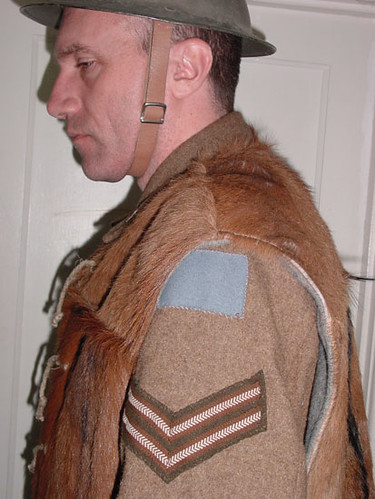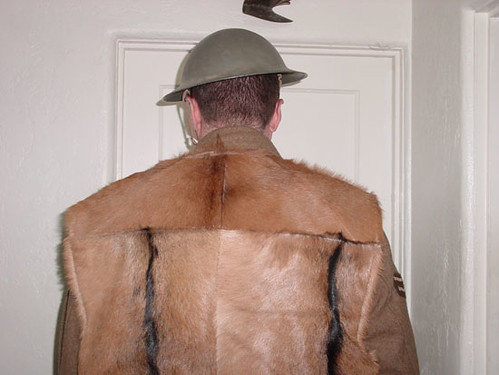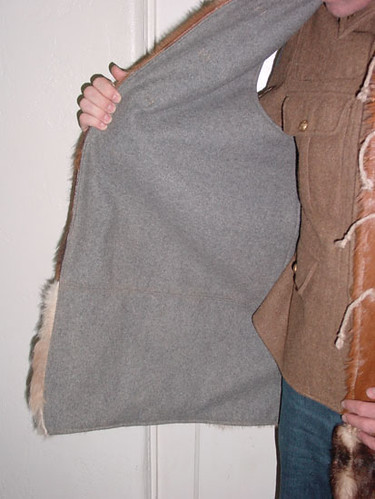I have been reenacting for almost 20 years to one degree or another, not counting the years playing war as a kid with the best uniforms I could muster. Back in those days, my green wind breaker and a helmet liner had to pass for everything, but when you are six, the imagination is wild and unabashed. Yes, when I was a kid we played war, and cowboys vs. wagon burners, etc. we never shot up a school or had an accidental discharge of a real gun resulting in the death of a playmate.
Our guns looked like guns, and shot caps. We made rules of engagement and stuck to them. Unlike today where just touching a day glo blaze orange plastic “marker” pistol that shoots marshmallows and fairy turds would lead directly to asthma and a Ritalin prescription; playing war lead to things like team work, fort building and this elusive cryptic thing called “exercise” that resulted in lowering our body mass, and building a healthy immune system.
But I digress…
I still play war these days, but our production budget is much better, and the authenticity demands that much higher. Recently I joined a WWI club, and have a lengthy report about a battle here.
This is not about the war however, but the costumes. Bill, my partner in crime, gun nut, and screen writer of several epic sci-fi legends has a good tendency of putting bad ideas in my head, calls me one day out of the blue and says “You know what we need for our WWI gack? Big fucking fur vests”…

Winter in the Somme was probably the most crap-tastic combat engagement since Napoleon lost 85% of his army in Russia. The commonwealth forces were in a mad scramble to make warm clothes, and the traditional wool greatcoats were a major drain on time and resources. Various provincial sources were called upon to make warm stuff fast. Using blankets, leather jerkins and civilian clothing expedited winter items trickled to the front. Of interest to this story was the raw fur jerkins that came out of the rural provinces of Canada, Australia, New Zealand and the greater united Kingdom.

Issue of goat hide jackets
These were made with a variety of hides, and either backed on the issue leather jerkin, or on a new vest made with surplus or repurposed material. So the question of the hour is how do you make an accurate historical reproduction out of an item that had no regulation and could be made out of anything?
The Project
As soon as Bill mentioned that we needed to do this, there was no question he was right. This was just too cool, and there was more than enough historical evidence to support that they were both made and used regularly.

Fortunately, Bill had hired us a big gun. Steve McCullogen , maker of historical military garments, costumer to the stars, was going to help. Steve runs a small business in southern California that both sells to historical reenactors, and makes ridiculously historically accurate movie costumes. To give you an idea, when he had the HBT material made for the marine costumes in HBO’s “The Pacific” miniseries, he actually acquired the original machine to mill the mil-spec cotton twill to make the fabric his uniforms were cut from.

On the set of HBO's "The Pacific"
just some of his awesome work.
Spray them with pam, stick them in the oven, throw them on your roof for a week, bone somebody on ebay.
Steve had made stuff for our forays into WWII, and was notorious in the mid 2000s for having some of the best Waffen SS camo out there.
Somebody once described me as the guy who either shows up to the party with strippers AND beer, or doesn’t show up at all.
Unfortunately Steve being a cottage industry beholden to the movie business, he had developed a reputation much the same. Sometimes he shows up with amazing one of a kind costume art, on other cases, guys who ordered rack items he keeps in inventory are left hanging six to eight months.
He was totally down for the project, and after finishing USMC and Japanese WWII costumes to outfit hundreds of extras, he was looking forward to the change of pace.
But would we be waiting on these until we were old and grey?

Good news bad news, he just so happened to have some major hunks of WWI era blanket wool that he was saving for a rainy day, the bad news is he was completely out of goat hides.
Bill calls me up and says “Anders, this is where you come in. I need several yards of goat hide, work your magic.” A few calls later yield nothing from the usual suspects, and overpriced micro-goat pelts on ebay. Finally, a source out of nowhere, a guy in Texas who gets fresh from the taco farm goat hides at a price that was right. Twenty-six food grade goat skins and a few crafty Fedex trips later and we were cooking.
Steve worked a miracle.
Literally 72 hours later, the hides were cut into squares, matched by texture and direction of hair and color, and attached to the vests made of the blanket material. In addition he added ties using period cord. Other than the goat, the whole thing was made using original material and in stunningly record time.












